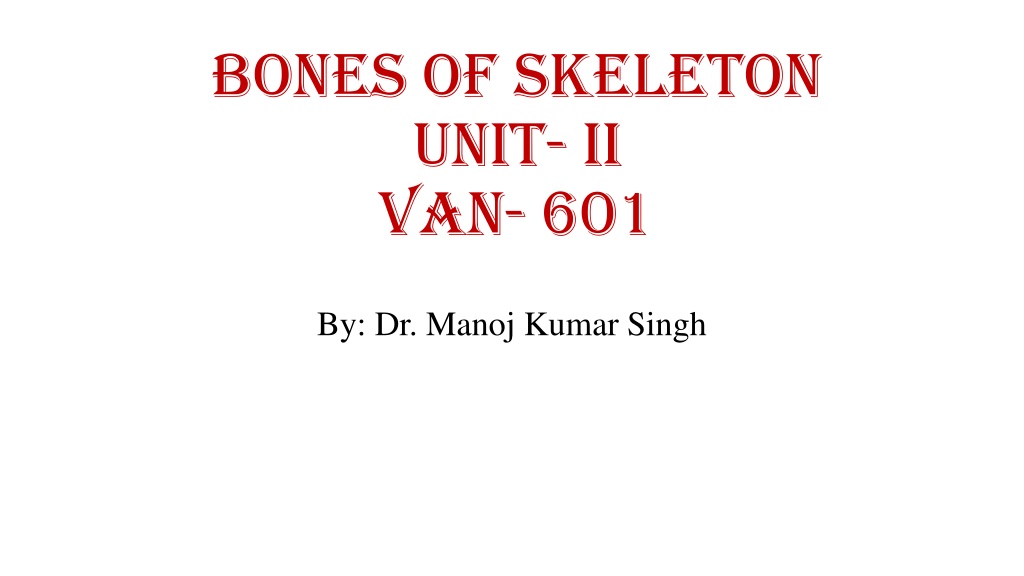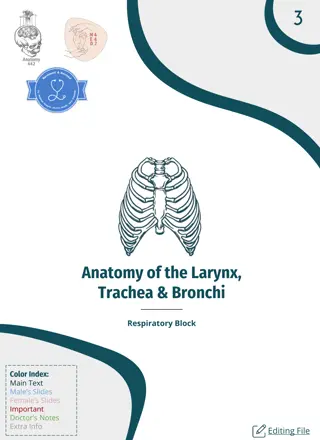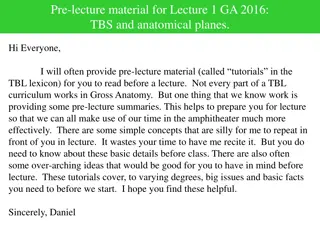Understanding Anatomy: Branches and Components of the Human Body
Anatomy, the study of body tissue structures, encompasses various branches including Gross Anatomy, Systematic Anatomy, and Microscopic Anatomy. Osteology focuses on the skeleton's components and functions as a crucial support system for the body, aiding in movement and protection of organs.
Download Presentation

Please find below an Image/Link to download the presentation.
The content on the website is provided AS IS for your information and personal use only. It may not be sold, licensed, or shared on other websites without obtaining consent from the author. Download presentation by click this link. If you encounter any issues during the download, it is possible that the publisher has removed the file from their server.
E N D
Presentation Transcript
Bones of skeleton Unit- ii van- 601 By: Dr. Manoj Kumar Singh
DEFINITION Anatomy is the branch of biological science, which deals with the forms and structure of the body tissue of animals and birds. The various parts of the body must work together to maintain the life and well-being of an animal. The term anatomy open or dissociating the parts of the body. means cutting
Branches of Anatomy Branches of Anatomy Gross anatomy / Macroscopic anatomy In gross Anatomy the structures are studied after dissection. There are many ways by which gross anatomy can be studied. Some important methods are as follow:-
Topographical /Regional Anatomy/ Surface Anatomy In this method the principal structures or organs of any part of the body are described in relation to a definite and limited area of the surfaces. For example, the anatomy of the neck region would include all the muscles, bones, organs, blood vessels and nerves present in the neck.
Systematic Anatomy The branch of anatomy which deals with the different systems in the animal body are studied one after another. E.g. Skeletal system, muscular system etc. Osteology (Bones) Arthrology (Joints) Myology (Muscles) Splanchnology (Visceral organs) Angiology (Cardio-vascular system) Neurology (Nervous system) Aesthesiology (Sense organs)
Histology and Cytology / Microscopic Anatomy Developmental Anatomy / Embryology The anatomy can also be classified as Special Anatomy which concerns with one species. Surgical Anatomy: This is an applied part of the subject where the structures of some specific sites are studied for application in surgical practice. Radiological Anatomy: Here studied with the help of X-ray, USG/MRI, C.T scan etc. Comparative anatomy compares with the other species.
Osteology: deals with the components of skeleton. Bones are principal components of a skeleton. It act as levers for muscle, protect certain viscera, manufacture blood cells and act as reservoir of mineral salt also. Skeleton: can be defined as a hard framework of the body which supports soft structures This is composed of bones, cartilages and ligaments. The skeleton is responsible for the maintenance of shape, flexibility as well as locomotion of the body. It is divided into two parts- Axial andAppendicular.
The axial skeleton comprises of the bones of skull, vertebral column, ribs and sternum. The appendicular skeleton consists of bones, which form the framework of the pectoral or forelimbs and the pelvic or hind limbs, including the elements.
Bones of Pectoral limb Pectoral girdle and shoulder region: Scapula, Coracoid and Clavicle. Arm: Humerus Forearm: Radius and Ulna Manus: Consisting of Carpus: A number of small bones called carpals arranged in the domestic mammals in two rows. Metacarpus: Typically consisting of five bones designated only by numbers 1 to 5, but showing considerable modifications in different animals.
Digits: These form the terminal parts of the limbs and usually correspond to the number of the fully developed metacarpals. These are also designated by numbers 1 to 5. Each digit is composed of a number of bones arranged serially called the phalanges. The number of phalanges may vary (from 1 to 5) within the species and also in different digits of the same species.
Bones of Pelvic limb Pelvic girdle and hip region: Ilium, ischium, and pubis, Thigh: Femur Leg: Tibia & fibula Pes: Consisting of Tarsus (3 rows) Metatarsus : similar to the forelimb Digits























